Take a look at the list of winners in the 2006 Edublog Awards
Or to cut straight to the chase go to Hey Jude
Well done Judy!
18 December 2006
14 December 2006
The Blended Librarian

Ever wondered why you are so tired all the time? Well, someone has found a name for the job we teacher librarians do and it explains everything:
"A blended librarian is one who combines traditional library and information technology skills with instructional design and technology skills and knowledge of collections of instructional resources and current trends in developing and distributing instructional resources. The blended librarian uses this combination, along with a heightened emphasis on pedagogy, to collaborate with faculty, information technologists, and instructional technologists/designers on the design of information literacy that is tightly integrated into the individual instructor’s courses and with broader programmatic curricular goals." http://www.ala.org/ala/acrl/acrlproftools/collaboration.htm
Find out more about Blended Librarianship and join this community at The Blended Librarian website. Expect a day or so delay for approval, and then explore what is on offer.
To hear the founders, John Shank and Steven Bell, download this Learning Times Green Room Podcast. The Green Room people made the mistake on an earlier podcast of commenting that librarians may be redundant soon. John and Steven beg to differ.
08 December 2006
Marco Torres
 Yesterday I was fortunate to ‘experience’ Marco Torres. What an inspirational afternoon – those who have attended his sessions this week are sure to agree. He made his work appear so easy – however, this man obviously has enormous energy and talent.
Yesterday I was fortunate to ‘experience’ Marco Torres. What an inspirational afternoon – those who have attended his sessions this week are sure to agree. He made his work appear so easy – however, this man obviously has enormous energy and talent.+ What did I take away -
1. Good pedagogy underlies and is implicit in his work
and
2. in practical terms -
+ We have Three options
- Complain
- Quit
- Innovate
+ Essential question is critical (this links to our 2006 AGQTP project at St Michael’s: higher order questioning)
+ Remember Einstein’s quote, ‘Don’t ask a question if you can look up’ [= ‘Google it’!]
+ When planning – always ask ‘Does the project have wings?’ – is there a wider audience outside the classroom?
+ Students don’t use technology, they do technology
+ Music is very important : Music is the ugly stepchild in multimedia : so - Find the musicians in the school and use them in multimedia projects
+ Be resourceful: Too many schools have many resources, but are not resourceful; Many schools have limited resources, and are resourceful
+ Creativity is the key - Remember the red paper clip – http://oneredpaperclip.blogspot.com/
+ Connect to the family
+ Connect to the community
Today my head is spinning – where to begin, and begin I will. It could be easy to be overcome by the quality of his projects, however, creativity with few resources is possible. There is no question students are motivated by technology, we all have supporting evidence - My experience with students and movie making has been exciting. I believe the real key is getting the pedagogy right – having the essential question.
If you have been one of the fortunate people to have Marco in your classroom/school this week – please share. We can all benefit from your experience. In the meantime -
1. Visit his website http://homepage.mac.com/torres21 .
2. Open sfett to view inspirational student produced movies.
3. Open flickschool for tips on getting started.
Wiki ideas for the classroom

So how do I use wikis with my classes?
Go no further for the answers!
Wiki Ideas for the classroom provides a flash tutorial outlining all the benefits of wiki, and all the practical considerations for good learning and teaching.
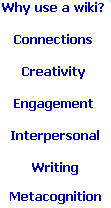 Not only are the learning and design issues covered, but the tutorial also provides information for consideration of safety, spelling, copyright and more.
Not only are the learning and design issues covered, but the tutorial also provides information for consideration of safety, spelling, copyright and more.Some suggestions include: a study guide; vocab list; organizational 'epicenter' for your student's learning on a topic (see the Aristotle experiment); collabortive research projects; an “everything I needed to know I learned in Ms.Teachername’s class” wiki where students add their own observations of ways the class knowledge has spilled over into the “real world”; A travelogue from a field trip or NON-field trip that the class would have liked to take as a culmination of a unit of study; and more....
For more information you may also go to Mark Wagner "Wikis while you Work: an Introduction to Wikis in education".
The tutorial is designed to support WikiSpaces which we promote on this blog.
06 December 2006
Travelling with Delicious ...
 This week is Transition week for Year 10s at Delany.
This week is Transition week for Year 10s at Delany.One of their sessions is an introduction to Delicious, and the creation of their own 'digital bookshelves' for their coming 2 years in the senior school.
We took the time to explain that when the new Intranet comes, they will be able to link their delicious accounts into their Intranet resources and have the best of both worlds.
Delicious has networking, but no chat or other contact between users, so it can be difficult to identify network members. We have asked students to precede their chosen username with DC and end with their year level. So DCsweetpie11 and DCalistair12 would be easy to identify as our students. They seem happy enough with this.
I think Marion College has also set up Year 10 with delicious accounts too.
Any other schools introducing Web 2.0 tools to their senior students?
Jan@Delany
Labels:
information literacy,
Library 2.0,
social software,
techtools
04 December 2006
Podcasting book talks!
A great idea from Michele Velthuizen Middle School Librarian American School of The Hague
"I recently started encouraging our middle school students to create video podcasts about their favorite books since peer recommendations sometimes work better than my own booktalks!
I set up my computer (a Mac Book Pro which has a built-in camera and microphone) in our reading room and have students come in during lunch break to create their recordings. They rehearse for a minute, then they record themselves using QuickTimePro which has a movie recording feature that is very easy to use. I then upload the podcast onto our library web page within minutes.
I've used these podcasts when classes come in to check out books and update their reading cards.
Click on this link http://fc.ash.nl/~mvelthuizen/, then click on "Watch a video podcast" on the main screen to see some samples.
To follow up from Marita's post on graphic novels, you might like to check out iFanboy.com.
 The iFanboy.com Comic Book Podcast is a weekly talk show discussing the best in current comic book releases.
The iFanboy.com Comic Book Podcast is a weekly talk show discussing the best in current comic book releases.
Ron, Conor and Josh will share what they loved and hated about the week's comics. With a deep, sometimes scary knowledge of the depths and intricacies of pop culture and the geek lifestyle, the conversations can spin off in many directions. While comics, graphic novels and trade paperbacks are the center of the iFanboy universe, the discussion often covers the video games, movies and TV shows which will capture the fancy of your regular comic book reader.
Something different for older students.
"I recently started encouraging our middle school students to create video podcasts about their favorite books since peer recommendations sometimes work better than my own booktalks!
I set up my computer (a Mac Book Pro which has a built-in camera and microphone) in our reading room and have students come in during lunch break to create their recordings. They rehearse for a minute, then they record themselves using QuickTimePro which has a movie recording feature that is very easy to use. I then upload the podcast onto our library web page within minutes.
I've used these podcasts when classes come in to check out books and update their reading cards.
Click on this link http://fc.ash.nl/~mvelthuizen/, then click on "Watch a video podcast" on the main screen to see some samples.
To follow up from Marita's post on graphic novels, you might like to check out iFanboy.com.
 The iFanboy.com Comic Book Podcast is a weekly talk show discussing the best in current comic book releases.
The iFanboy.com Comic Book Podcast is a weekly talk show discussing the best in current comic book releases.Ron, Conor and Josh will share what they loved and hated about the week's comics. With a deep, sometimes scary knowledge of the depths and intricacies of pop culture and the geek lifestyle, the conversations can spin off in many directions. While comics, graphic novels and trade paperbacks are the center of the iFanboy universe, the discussion often covers the video games, movies and TV shows which will capture the fancy of your regular comic book reader.
Something different for older students.
28 November 2006
Getting Graphic
 I started a new discussion at Read On today asking people to share student’s current favourite reads, with a view to starting some recommended lists for various age groups. Please join in when you get the chance – it will be interesting to compare notes.
I started a new discussion at Read On today asking people to share student’s current favourite reads, with a view to starting some recommended lists for various age groups. Please join in when you get the chance – it will be interesting to compare notes.When answering my own question first thoughts were about our comic collection, maybe because this was discussed on OZTL last night. Here is a bit of what I posted to that discussion, plus some local additions to the literature:
At Patrician Brothers our graphic novels are a big hit across the board. Like certain series books (Harry Potter, Deltora Quest, Alex Rider, Darren Shan) they have an appeal to reluctant and avid readers alike. In this sense they are a real boon in our efforts to develop a reading culture. Whilst many boys read books as well, some are having their first (and maybe only) positive reading experience with comics.
Earlier in the year I was travelling home on the train from our athletics carnival with the boys and was chatting with one of our very avid Year 8 readers. He was reading a graphic novel and said to me that it was actually taking him longer to read than a novel (and he is a very fast reader). We had an interesting conversation about why that might be. I don't think we should undervalue the visual.
Favourite links to resources on this topic:
Secret Origin of Good Readers
Free book download. Check down the page for the 2006 version. Plenty of quotes,links, annotated reviews, information for librarians and teaching activities.
The "Decline" of Reading in America, Poverty and Access to Books, and theuse of Comics in Encouraging Reading by Stephen Krashen, Teachers CollegeRecord, February, 2005 (More in Krashen's book The Power of Reading - search here for local publication details)
Di Laycock of Barker College has published an article and completed an action research project on graphic novels, adding a much needed Australian flavour to this field:
Developing a Graphic Novel Collection, Synergy, Vol.3, Num.2 (PDF)
Getting graphic with guys: Using graphic novels to engage boys in school reading From this page choose IBSC 2005/06 Action Research Project from the menu on the left.
Okay, I know you don't have time for all this reading. Maybe in the holidays?
Search the Biblioblogosphere and Beyond
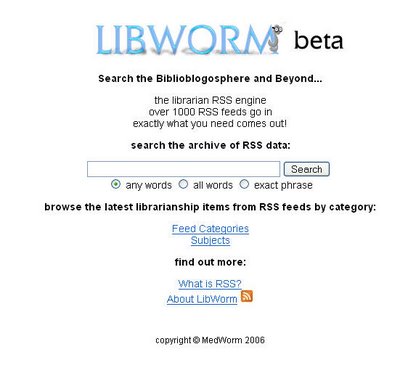
It's worth taking a look at LibWorm to find the latest items of interest in librarianship - join LibWorm and create your own reading list, collect your favourite feeds, or just collect clippings. Choose from Feed Categories or Subjects. Nice one!
Of course, this also had to come along from Google! Go take a look!
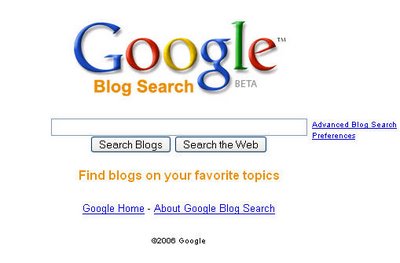
24 November 2006
Web2.0 & Primary Students
I wish to share an ICT initiative from St Michael’s, Baulkham Hills, and I hope we receive some responses to guide our future planning!
A colleague and I attended an Introduction to Podcasting course and as a result our Year threes and a class of year 4s have been introduced to podcasting this term …by two novices! They have been our second ‘group’ of learners to embrace Web2.0.
Audacity [free download] is the program we are using for creating the audio file, then using Lame [free download] to convert the files to MP3. We are yet to load the files to the web. Our students have been highly motivated by the opportunity to publish their research and understandings using podcasting. This is the positive aspect of the tool, combined with the students demonstrating some prior knowledge and understanding of audio - In year 3 we were able to add some ‘zing’ to the important [dry!] topic of Recycling!
Evidence from this exercise has informed us of the possibilities of podcasting with younger students. We have the opportunity to combine this with evidence gathered from our St Michael’s AGQTP project. Both projects indicate high levels of student motivation when they engage in a social networking environment. We used www.think.com as the tool for social networking in our AGQTP project. In that project, we were able to gather data not only related to our research question, but on many other areas including the social and ethical use of computers. For example: we elected to use the online tool Think.com as a secure environment for our research project. Several discussions were held with the students regarding social and ethical behaviours in the Web2.0 environment. Despite this, we had evidence of inappropriate comments from [unexpected!] students towards others. Think.com was therefore a scaffold, a secure and controlled environment - valuable discussion ensured, thus scaffolding primary students into the Web2.0 environment.
Moving into 2007, I foresee a wider use of these two environments at St Michael’s.
Radio WillowWeb scaffolds students, and I believe this is a model worth replicating as we enhance student learning. Think.com has the facility to upload multimedia files [i.e. podcasts], thus providing a secure environment to develop our students’ ethical use of the Web2.0 environment.
Please comment and give us encouragement to keep developing ‘authentic’ Web2.0 educational pedagogy in our large primary school…with all its associated issues relating to access to hardware etc etc!
A colleague and I attended an Introduction to Podcasting course and as a result our Year threes and a class of year 4s have been introduced to podcasting this term …by two novices! They have been our second ‘group’ of learners to embrace Web2.0.
Audacity [free download] is the program we are using for creating the audio file, then using Lame [free download] to convert the files to MP3. We are yet to load the files to the web. Our students have been highly motivated by the opportunity to publish their research and understandings using podcasting. This is the positive aspect of the tool, combined with the students demonstrating some prior knowledge and understanding of audio - In year 3 we were able to add some ‘zing’ to the important [dry!] topic of Recycling!
Evidence from this exercise has informed us of the possibilities of podcasting with younger students. We have the opportunity to combine this with evidence gathered from our St Michael’s AGQTP project. Both projects indicate high levels of student motivation when they engage in a social networking environment. We used www.think.com as the tool for social networking in our AGQTP project. In that project, we were able to gather data not only related to our research question, but on many other areas including the social and ethical use of computers. For example: we elected to use the online tool Think.com as a secure environment for our research project. Several discussions were held with the students regarding social and ethical behaviours in the Web2.0 environment. Despite this, we had evidence of inappropriate comments from [unexpected!] students towards others. Think.com was therefore a scaffold, a secure and controlled environment - valuable discussion ensured, thus scaffolding primary students into the Web2.0 environment.
Moving into 2007, I foresee a wider use of these two environments at St Michael’s.
Radio WillowWeb scaffolds students, and I believe this is a model worth replicating as we enhance student learning. Think.com has the facility to upload multimedia files [i.e. podcasts], thus providing a secure environment to develop our students’ ethical use of the Web2.0 environment.
Please comment and give us encouragement to keep developing ‘authentic’ Web2.0 educational pedagogy in our large primary school…with all its associated issues relating to access to hardware etc etc!
Labels:
information literacy,
pedagogy,
podcasting,
primary,
web 2.0
19 November 2006
Read On! - An update from Marita

At last Thursday’s Network/PD Day we neglected to give the group an update on our readers’ advisory initiative, launched at an after school meeting on 9th November. The “plan” (in its most flexible sense) is to start with course materials provided by the good people at NoveList (part of our EBSCO database suite) and develop our own local context support materials.
WHAT IS READERS’ ADVISORY?
Readers’ advisory is that part of our role where we assist students to discover reading which matches their wants. Like the reference interview, it is a specialised interaction and a good opportunity to practice one of our great potential strengths: the human touch. Stephen Abram in Waiting for your cat to bark – Competing with Google and its Ilk, Part 3 suggests the following summary of where opportunity lies for libraries:
Librarians aren’t just about search; we’re about improving the quality of the question. End users are about “find and discover.” We need to be clear on that. If we focus on search, we are focusing on Google’s best game. If we focus on the question, the human touch, and overall customer experience, then we will not only survive, we’ll thrive.And, of course, in schools readers’ advising skills have relevance for teacher librarians, library assistants and classroom teachers.
RA-101 Lite
The course materials provided are based on sound principles developed from research and practice. However, most examples are about adult users and the references used are not Australian. Thus the need for local content.
RA-101, full version, was a joint project of EBSCO’s NoveList and the St. Louis Public Library, Minnesota. It grew out of a manual called Talking With Readers: A Workbook for Readers’ Advisory, by Duncan Smith and Suzanne Mahmoodi, Ipswich, Mass.: Ebsco, 2000, which is available from NoveList as a PDF file for subscribers. (Readers’ Advisory tab.)
Talking With Readers was developed using action research, but that is another (very interesting) story!
READ-ON!
Thanks to Frances Manning we have a wiki space and a good name for our context building exercise. When you go to Read-On! Click on “Manage Space” to see who has joined (about five so far). Contact a member and and ask them to send you an invitation to join. (Also done from Manage Space by a member). The space is evolving and contributions are eagerly awaited.
Finally another quote from Stephen Abrams' article:
“Blessed are the meek, for they shall inherit the earth.” Let’s be clear – that’s too long term – we need to do something now.
Introducing our next super contributor!
Welcome to our newest contributor, Marita Thomson, who has been 'blasting the cyberwaves' for what seems like 'forever'! Marita is busy exploring all sorts of digital and web tools in her work at Patrician Brothers.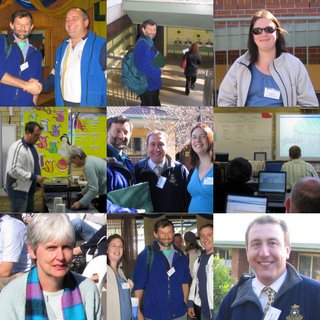
There's Marita, bottom left, with some of the other attendees at the IWB 2006 conference. I'll leave it to her 'showcase' her initiatives. Let me just say - they are ALL worthwhile.
Smart Learning is just one of these...and there are more. Don't you just love how easy it is to learn from each other?

There's Marita, bottom left, with some of the other attendees at the IWB 2006 conference. I'll leave it to her 'showcase' her initiatives. Let me just say - they are ALL worthwhile.
Smart Learning is just one of these...and there are more. Don't you just love how easy it is to learn from each other?
15 November 2006
Welcome to our Newest Contributor!
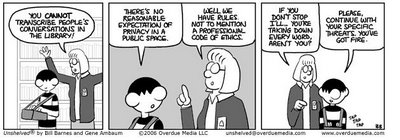
One way or another, there's been a lot going on in some of our school libraries that needs to be shared with with others. Collaboration and the social networking power of Web 2.0 means ....... you guessed it - time for this blog to develop and more in to a newer phase.
Patricia Lee from St Michael's has joined me as a co-contributor (read 'blog team member'), so that she can share directly some of the things that are happening at her school as well as explore the world of 'professional' blogging.
Watch this space for Patricia's contributions........................
Are you keen to explore the world of 'professional' blogging too? I would welcome a couple of other keen and regular bloggers to our Weekly Update.
Lets make this blog a great place to share discoveries as well as initiatives and achievements in our schools.
Virtual Bookshelf - the 'shelfari' possibilities.....
 I spotted this, and thought that this new Web 2.0 tool provides a great virtual tool, to create a great virtual display, and provide the option for virtual sharing of books.
I spotted this, and thought that this new Web 2.0 tool provides a great virtual tool, to create a great virtual display, and provide the option for virtual sharing of books.I can see a virtual display like this sitting quite nicely as part of a library web site, library wiki, CeNet, or just a classroom blog.
Imagine the possibilities for promoting reading - premier's reading challenge? or anything really.........
Seems like a cool tool. Can't wait to see who gives Shelfari first go!

08 November 2006
We're Wondering - questions from Year 3

Have you got computers and library books handy? Looking for an information hunt to help kids in another school. Then why not dive right into the questions being asked by the 'minilegends' from Glenelg school in SA.
Al Upton visited us at Parramatta recently, and met some of our teachers. Al works hard exploring learning opportunities using technology.
So visit "We're Wondering" podcasts, listen to the kids questions (divide them up for your own kids perhaps) and get the kids to write a comment back with an answer to one of the questions. Al explains how he did these podcasts (easy tools) and how he made them accessible using box.net, the free online storage solution, which we promoted recently.
We're Wondering Podcasts
It would be great if a couple of classes could reply to the children soon! Or perhaps you have some lunchtime library users who would enjoy this challenge.
07 November 2006
Book Plates - from My Home Library
Anne Fine welcomes readers to My Home Library with the following words:
Every day, we get messages from people who've just been told about us, or have stumbled upon The Home Library by accident. Schools, families and libraries all over the world: they're all delighted with our bookplates. Some of you are even making requests for different wordings that will suit you better. We're working on these as fast as we can, so keep checking.
Schools, families and libraries all over the world: they're all delighted with our bookplates. Some of you are even making requests for different wordings that will suit you better. We're working on these as fast as we can, so keep checking.
For new visitors, let me assure you our bookplates can be used any way you like (except for commercial purposes). Some people print onto sticky labels; others print on paper, then use scissors and glue. (Don't forget you can always print out the black and white plates on coloured paper. Some look remarkably different against a fresh background.)
Everyone needs a Home Library. Make sure that yours keeps growing. Don't forget that books furnish the mind, and unfurnished minds are EMPTY and TIRESOME.
 You will find black and white, as well as coloured book plates, in all shapes and sizes. There are lots of other good links too, including bookmarks, book reviews, tips & tricks, and more.
You will find black and white, as well as coloured book plates, in all shapes and sizes. There are lots of other good links too, including bookmarks, book reviews, tips & tricks, and more.
So dip in and enjoy!
Every day, we get messages from people who've just been told about us, or have stumbled upon The Home Library by accident.
 Schools, families and libraries all over the world: they're all delighted with our bookplates. Some of you are even making requests for different wordings that will suit you better. We're working on these as fast as we can, so keep checking.
Schools, families and libraries all over the world: they're all delighted with our bookplates. Some of you are even making requests for different wordings that will suit you better. We're working on these as fast as we can, so keep checking.For new visitors, let me assure you our bookplates can be used any way you like (except for commercial purposes). Some people print onto sticky labels; others print on paper, then use scissors and glue. (Don't forget you can always print out the black and white plates on coloured paper. Some look remarkably different against a fresh background.)
Everyone needs a Home Library. Make sure that yours keeps growing. Don't forget that books furnish the mind, and unfurnished minds are EMPTY and TIRESOME.
 You will find black and white, as well as coloured book plates, in all shapes and sizes. There are lots of other good links too, including bookmarks, book reviews, tips & tricks, and more.
You will find black and white, as well as coloured book plates, in all shapes and sizes. There are lots of other good links too, including bookmarks, book reviews, tips & tricks, and more.So dip in and enjoy!
Subscribe to:
Posts (Atom)


